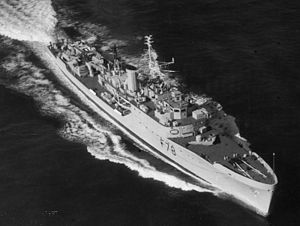HMS Blackwood was the name ship of her class (also known as the Type 14-class frigate) of second-rate anti-submarine frigates built for the Royal Navy in the 1950s.
 HMS Blackwood, 30 August 1957 (IWM)
| |
| History | |
|---|---|
| Name | HMS Blackwood |
| Namesake | Henry Blackwood |
| Builder | John I. Thornycroft & Company |
| Laid down | 14 September 1953 |
| Launched | 4 October 1955 |
| Commissioned | 22 August 1957 |
| Identification | Pennant number: F78 |
| Fate | Broken up 1976 |
| General characteristics | |
| Class and type | Blackwood-class frigate (Type 14 frigate) |
| Displacement | 1,456 long tons (1,479 t) full load |
| Length | 310 ft (94.5 m) |
| Beam | 33 ft (10.1 m) |
| Draught | 15 ft (4.6 m) |
| Installed power |
|
| Propulsion | 1 shaft; 1 steam turbine set |
| Speed | 27 knots (50 km/h; 31 mph) |
| Range | 5,200 nmi (9,600 km; 6,000 mi) at 12 knots (22 km/h; 14 mph) |
| Complement | 140 |
| Sensors and processing systems |
|
| Armament |
|
Description edit
The Blackwood class displaced 1,180 long tons (1,200 t) at standard load and 1,456 long tons (1,479 t) at deep load. They had an overall length of 310 feet (94.5 m), a beam of 33 feet (10.1 m) and a draught of 15 feet (4.6 m). The ships were powered by one English Electric geared steam turbine that drove the single propeller shaft, using steam provided by two Babcock & Wilcox boilers. The turbine developed a total of 15,000 shaft horsepower (11,000 kW) and gave a maximum speed of 27 knots (50 km/h; 31 mph).[1] The Blackwoods had a range of 4,500 nautical miles (8,300 km; 5,200 mi) at 12 knots (22 km/h; 14 mph). Their complement was 140 officers and ratings.[2]
The ships were armed with three Bofors 40 mm guns in single mounts. The mount on the quarterdeck was later removed as it was unusable in heavy seas. The first four ships to be completed, including Blackwood, were fitted with two above-water twin mounts for 21-inch (533 mm) anti-submarine homing torpedoes, but these were removed in the early 1960s. They were equipped with two triple-barrelled Limbo Mark 10 anti-submarine mortars. The Blackwood-class ships had the same sonar suite as the larger Whitby-class frigates where the Limbo mortars were controlled by three sonars, the Type 174 search set, Type 162 target-classification set and the Type 170 'pencil beam' targeting set to determine the bearing and depth of the target.[3]
Notes edit
Bibliography edit
- Colledge, J. J.; Warlow, Ben (2006) [1969]. Ships of the Royal Navy: The Complete Record of all Fighting Ships of the Royal Navy (Rev. ed.). London: Chatham Publishing. ISBN 978-1-86176-281-8.
- Friedman, Norman (2006). British Destroyers and Frigates, the Second World War and After. Annapolis, Maryland: Naval Institute Press. ISBN 1-86176-137-6.
- Gardiner, Robert; Chumbley, Stephen & Budzbon, Przemysław (1995). Conway's All the World's Fighting Ships 1947-1995. Annapolis, Maryland: Naval Institute Press. ISBN 1-55750-132-7.
- Marriott, Leo (1983). Royal Navy Frigates 1945-1983. Shepperton, Surrey, UK: Ian Allan. ISBN 0-7110-1322-5.